MB&F rarely introduces objets d’art so visibly rooted in horology as Kelys & Chirp: the Geneva-based independent watchmaker generally specializes in exotic and futuristic shapes, which, while still rooted in haute horology, rarely wear their origins on their sleeves. Great examples are the Horological Machine No. 6 Alien Nation and the Destination Moon clock, while the Starfleet Machine is a lesson in MB&F’s style of creativity that doesn’t tell the time, preferring to show its roots in its craftsmanship instead.
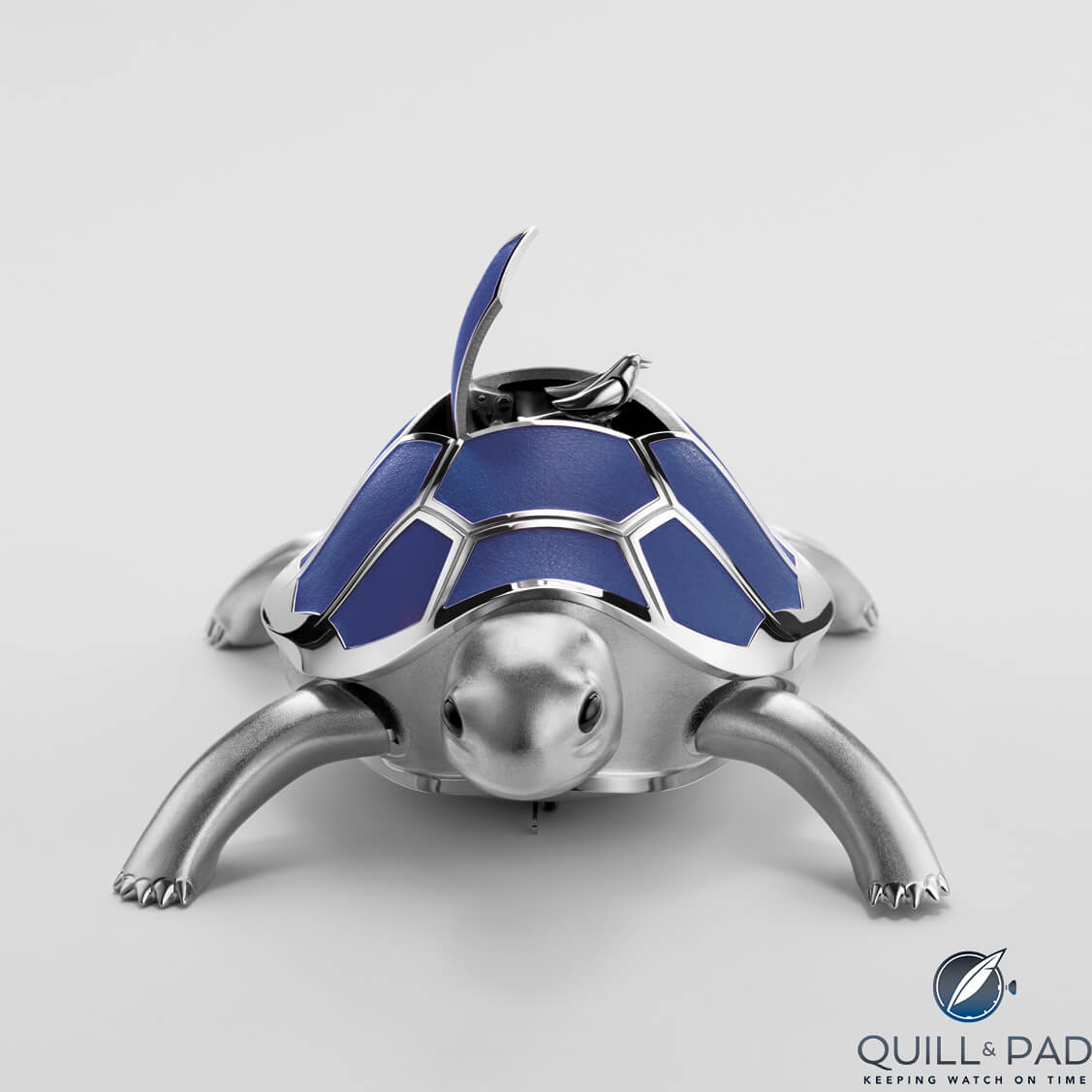
MB&F Kelys & Chirp Blue
Kelys & Chirp doesn’t tell the time. It is an automaton – and most automata grew from advances made in horology in the 1600s. Pierre Jaquet Droz (1721–1790) was perhaps the most famous automaton maker of his time, exhibiting a rare skill that continues to permeate the horological world to this day.
In English, the word “clockwork” is still often used to denote mechanical, “windup” items that even include the type of toy that I remember from my own childhood. These were usually powered by keys, cranks, or even strings that triggered springs, which in turn powered gearing.
The earliest of these types of automata can well be called “mechanical toys” and they were made for European (and later Asian) aristocracy.
The turtle began appearing as a symbol of wisdom, knowledge, and longevity in the folklore of a variety of cultures as early as ancient Mesopotamia, and it persists in this role up to today with perhaps environmentalism added to its range of connotative symbols. It’s no wonder it, too, showed up in horology and automata as early as the 1600s.

MB&F Kelys & Chirp Ochre (left) and Yellow
A brief history of turtle automata
While automata were – and still are – reserved for just a lucky few owners throughout history some examples continue to exist, passed on from generation to generation through auction houses, museums, and collections of rare objects.
Around 1610, Georg Fronmiller of Augsburg, Germany crafted a turtle automaton clock in gold-plated copper, iron, brass, bronze, wood, silver, and enamel, making this most likely the earliest known turtle automaton. It is currently at home in the Princely Treasury of the Hessian Museum (Fürstliche Schatzkammer, Hessisches Landesmuseum) of Darmstadt.
An example of a walking tortoise recently sold by the Breker art auction house in Cologne is still in existence from the 1920s. A spring mechanism wound by key allows the paper-maché-and-wood animal with articulated head and limbs to realistically crawl.
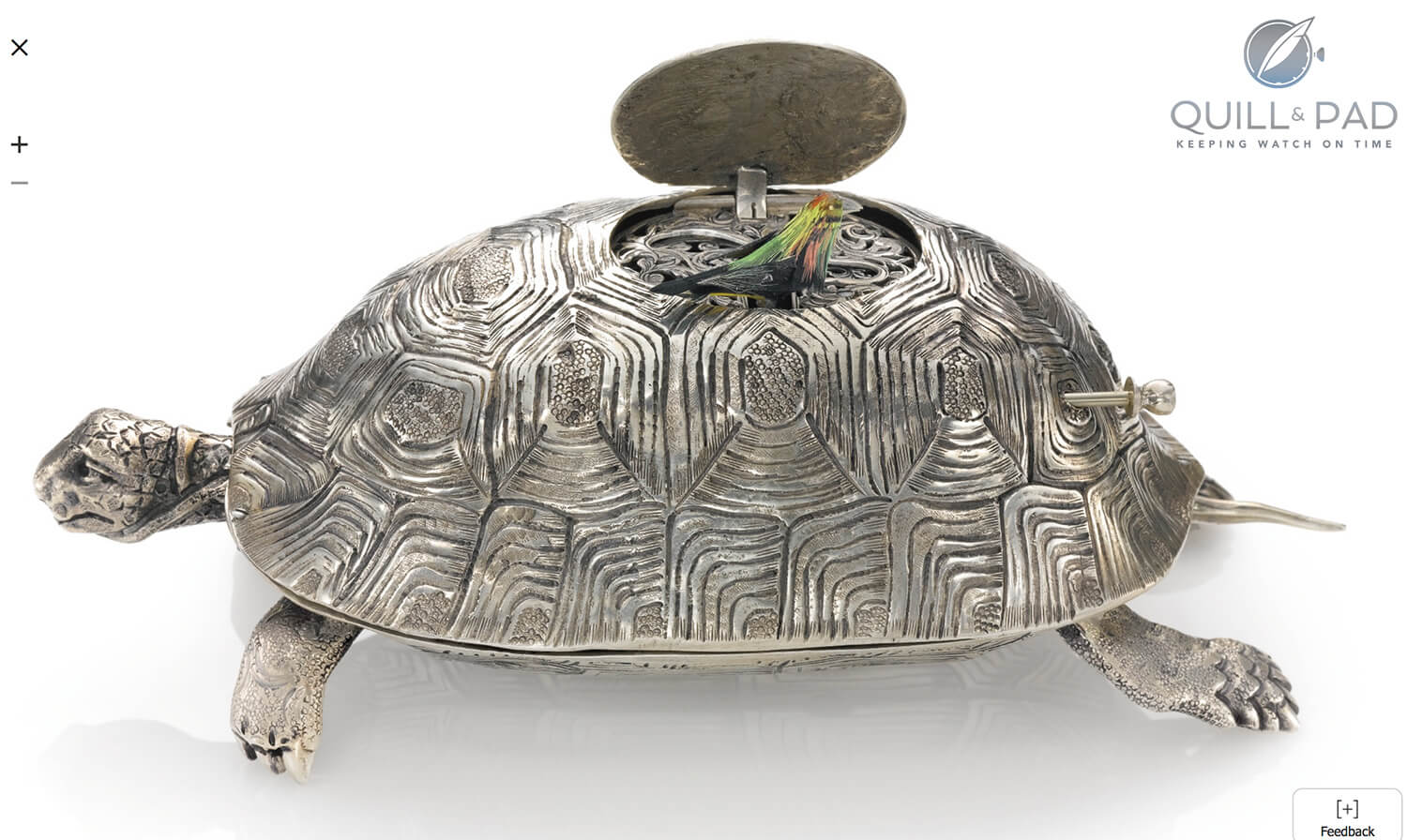
Key-wound silver turtle automaton with a singing bird in its shell made in Germany in about 1975 (photo courtesy Sotheby’s)
More decorative instances were made in the twentieth century, with Sotheby’s in 2013 having auctioned an interesting key-wound silver turtle automaton with a singing bird in its shell made in Germany in about 1975. While the work is not attributed, it certainly docks into the tradition begun there in the 1600s. This turtle’s silver case is elaborately engraved to represent turtle scales; its head moves when the bird sings. The bird additionally flaps its wings and moves its beak.
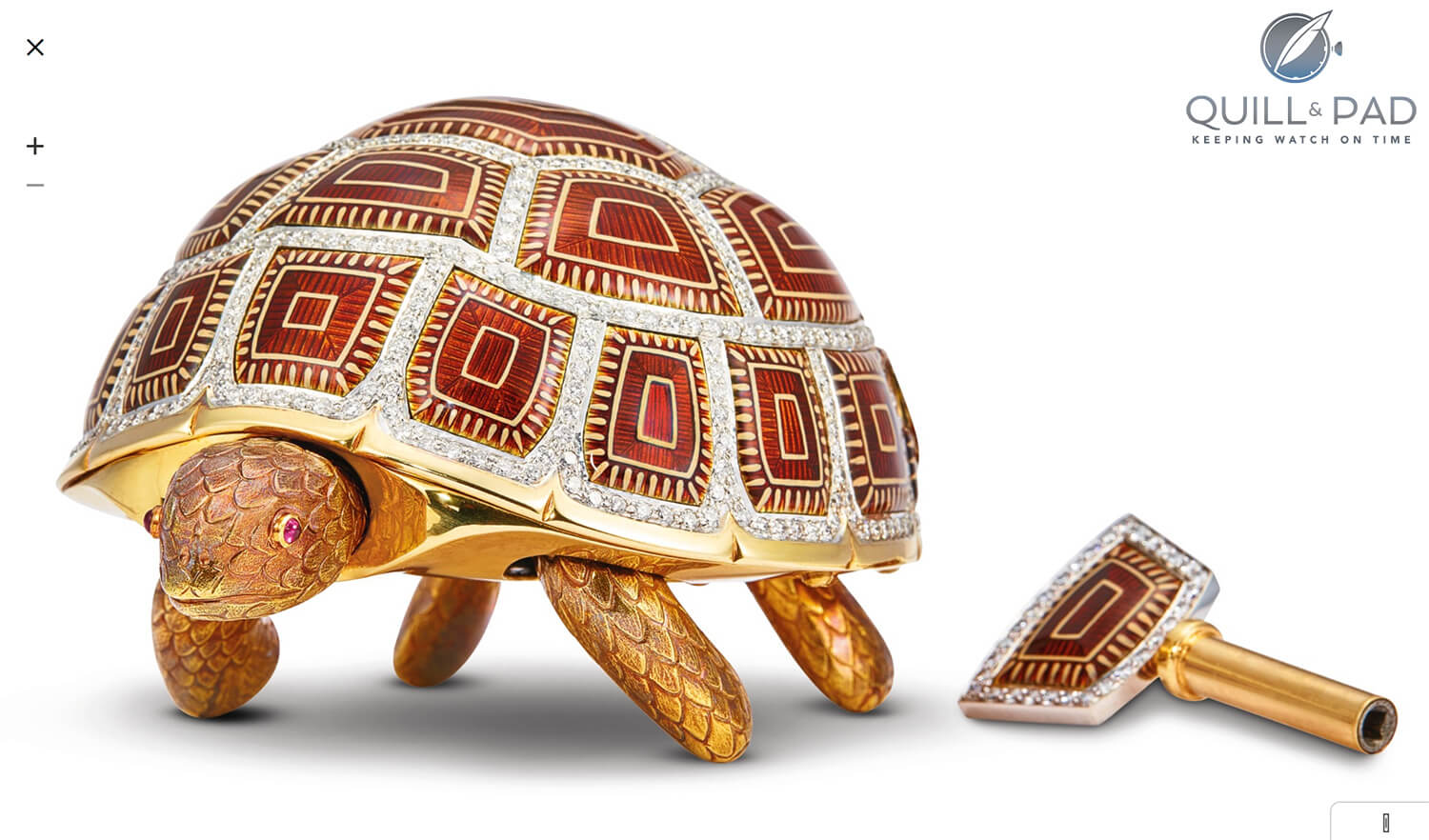
Asprey tortoise with winding key from 1989 in yellow gold, enamel, and diamonds (photo courtesy Sotheby’s)
In 2016, Sotheby’s once again auctioned a turtle automaton, this time made by Asprey in 1989. This example wound by key is ultra-luxurious in yellow gold, enamel, and diamonds. When the automaton is activated, the turtle crawls and its head moves.
Independent watchmaker Raul Pagès created a one-of-a-kind white gold turtle automaton in 2013, also wound by key. When the automaton set with diamonds on its feet and featuring sapphires for eyes is activated the turtle does a little dance that propels its forward, its head moving to the same rhythm thanks to a fully handcrafted movement comprising more than 300 components. Its beautiful blue shell has been engraved and enameled by Swiss masters of the craft.
“My vision was to redefine the art of automata in a contemporary way with a unique, totally handmade (no CNC) tortoise with the utmost quality of finishing,” Pagès said as part of a greater conversation involving tortoise automata upon release of MB&F’s Kelys & Chirp in late 2017.
MB&F Kelys & Chirp
“We were inspired by a long line of turtle automatons that go back to the early 1600s, through the 1900s, and of course Raul Pagès’ beautiful ‘piece unique’,” MB&F founder Maximilian Büsser recently explained the origins of Kelys & Chirp within this same greater conversation. “Our ‘Friends’ on this co-creation [the “F” in “MB&F” stands for “Friends”] are Reuge, who have the singing bird know-how, and Nicolas Court, an expert in automata.”
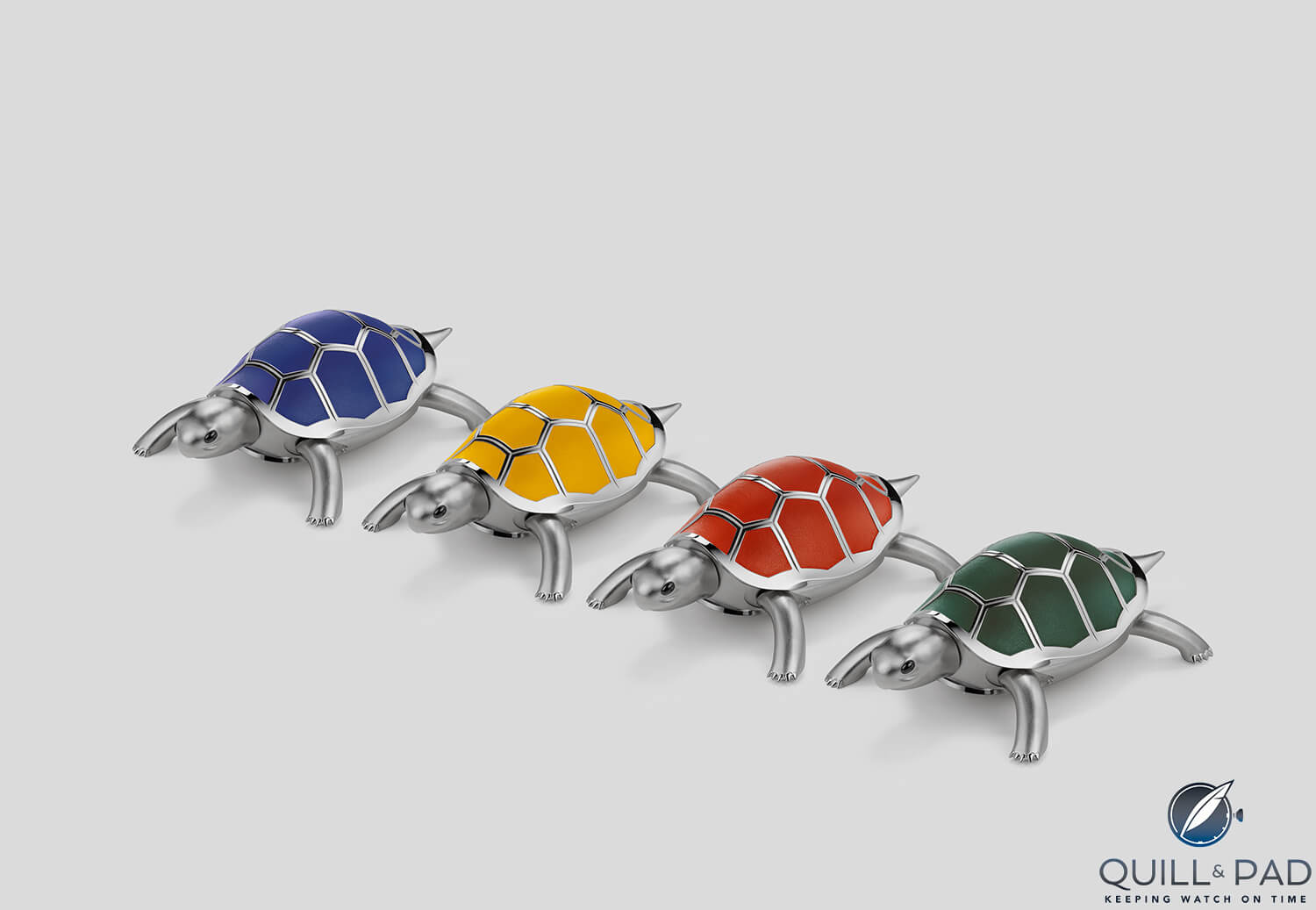
The MB&F Kelys & Chirp collection
Kelys is a rhodium-plated brass tortoise, whose name originates in the Greek word for chelonian reptiles (turtle, terrapin, tortoise), while Chirp is a white gold singing bird with sapphire eyes that Kelys carries in and on his back.
Like the silver German example above from 1975, Chirp emerges from one of the scales to sing, flap wings, move its tail, and open its beak for 10-12 seconds.
This incredibly complicated animal combo comprises 480 individual components and weighs in at a surprisingly hefty 1.4 kilograms. Nicolas Court and his team based in Sainte-Croix, Switzerland, developed the turtle’s mechanism so that its power comes from the singing bird’s mainspring. The turtle’s mechanism operates in a similar way to a complication module added to a wristwatch movement.
The turtle’s low ratio elliptical gearing ensures that minimal energy is required to set the long-lived animal in motion, while cams move the legs – which, incidentally, realistically replicate a turtle’s gait, where the animal pushes off with both rear legs while the front pair of legs catches up.
Perhaps the coolest element of this is the friction clutch security system Court added so that Kelys is able to detect surface edges; this mechanical element gives the turtle the ability to avoid falling to its destruction from a desk or table.
Jaquet Droz’s singing bird
To create Chirp, Reuge utilized a 230-year-old invention that is generally credited to Pierre Jaquet-Droz. By 1785, Jaquet-Droz had both miniaturized a mechanically controlled bird and developed a compact movement to control its motions. He was successful in miniaturizing a realistic birdsong by using a single bellow of variable pitch with a sliding piston rather than multiple single-pitch bellows that were commonly used up until then.
The quality of the bird’s song and how well it carries – even in modern-day Jaquet Droz’s creations, which use a newer technology involving three sapphire crystal tubes with a carbon fiber piston to create air compression – are astonishing (see The Whimsical Song Of Jaquet Droz’s Charming Bird and Jaquet Droz’s Magnificent Charming Bird Returns In An Exquisite Métiers d’Art Version).
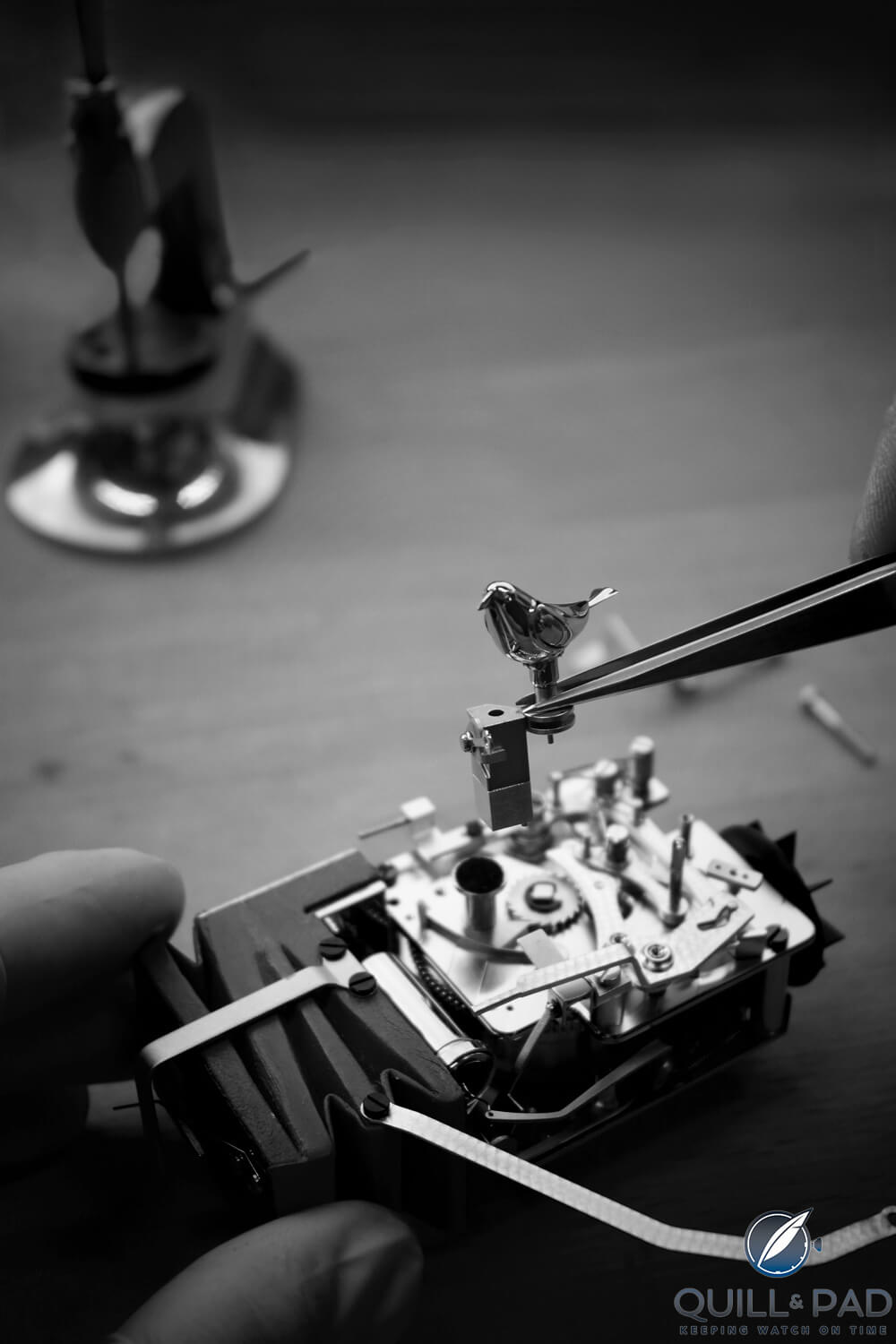
Assembling the singing bird movement for MB&F’s Kelys & Chirp
Reuge, a company that has been continuously manufacturing its amazing music boxes and luxury objects for more than 150 years, continues to use Pierre Jaquet-Droz’s original technology for its traditionally minded bird.
And Reuge invented a security system for the bird as well: if Chirp or the piece of leather turtle shell scale that covers her when she’s not singing are accidentally pushed down mid-song, she instantly ceases and retreats. No harm done (which would not have been the case on antique songbird automata).
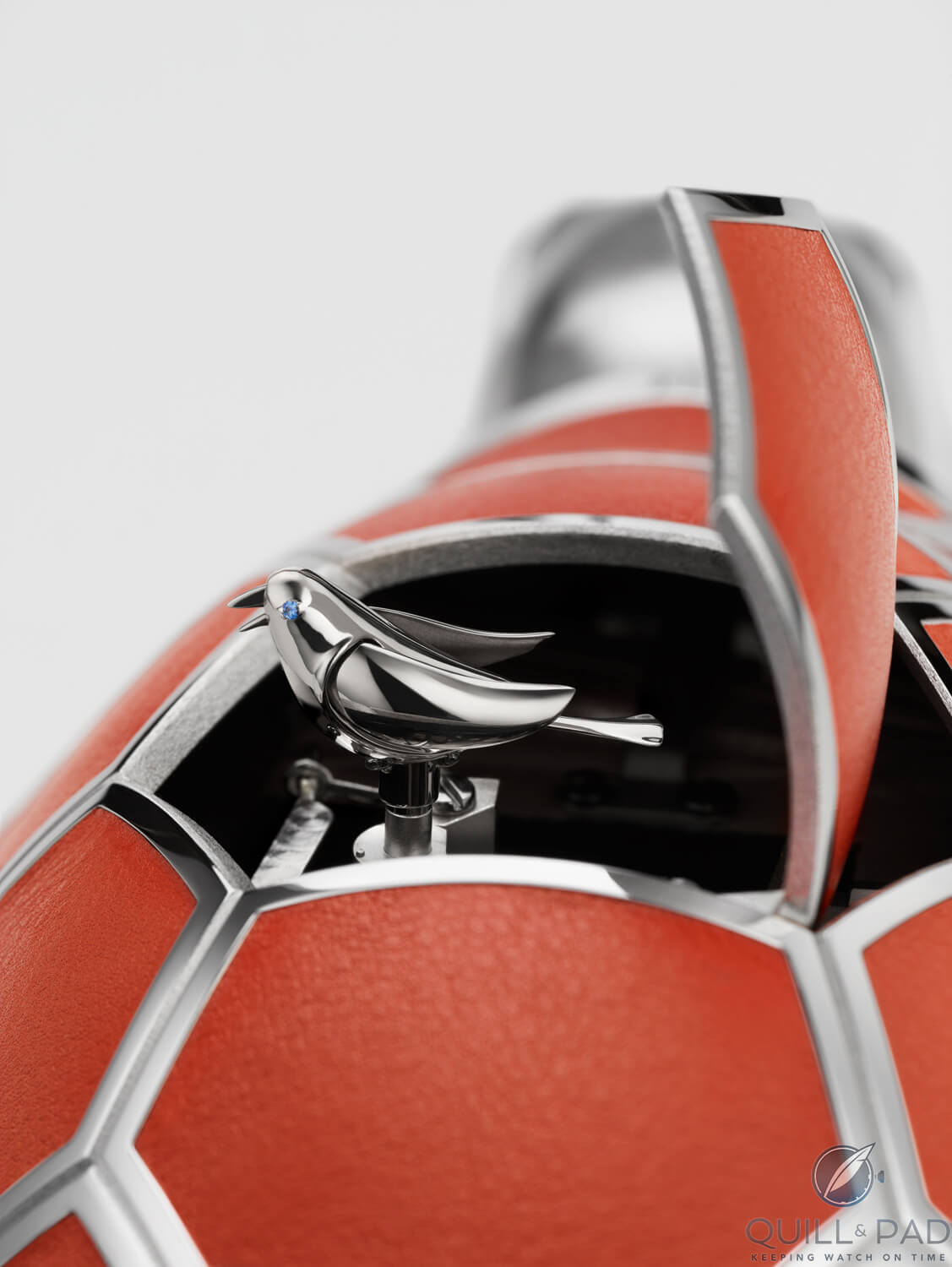
Chirp
Büsser, in talking with Reuge CEO Kurt Kupper on how to shed new light on the traditional singing bird – which is the actual point of MB&F’s inspiration in presenting Reuge and Court’s collaborative piece – says the idea came very naturally. “I looove automatons, and five years ago had already gone to see Franҫois Junod in Sainte-Croix,” the enthusiastic company founder explained to me in a recent interview, citing the famous modern-day creator of such oeuvres as the Van Cleef & Arpels Fée Ondine and the Parmigiani Fleurier Hippologia.
“Kelys & Chirp is the first in a series of singing bird concepts we discussed with Reuge and Nicolas Court,” Büsser revealed to me. “In this series, the base of the singing bird is a different animal each time; the next one is an elephant automaton with a singing bird also coming out of its back.”
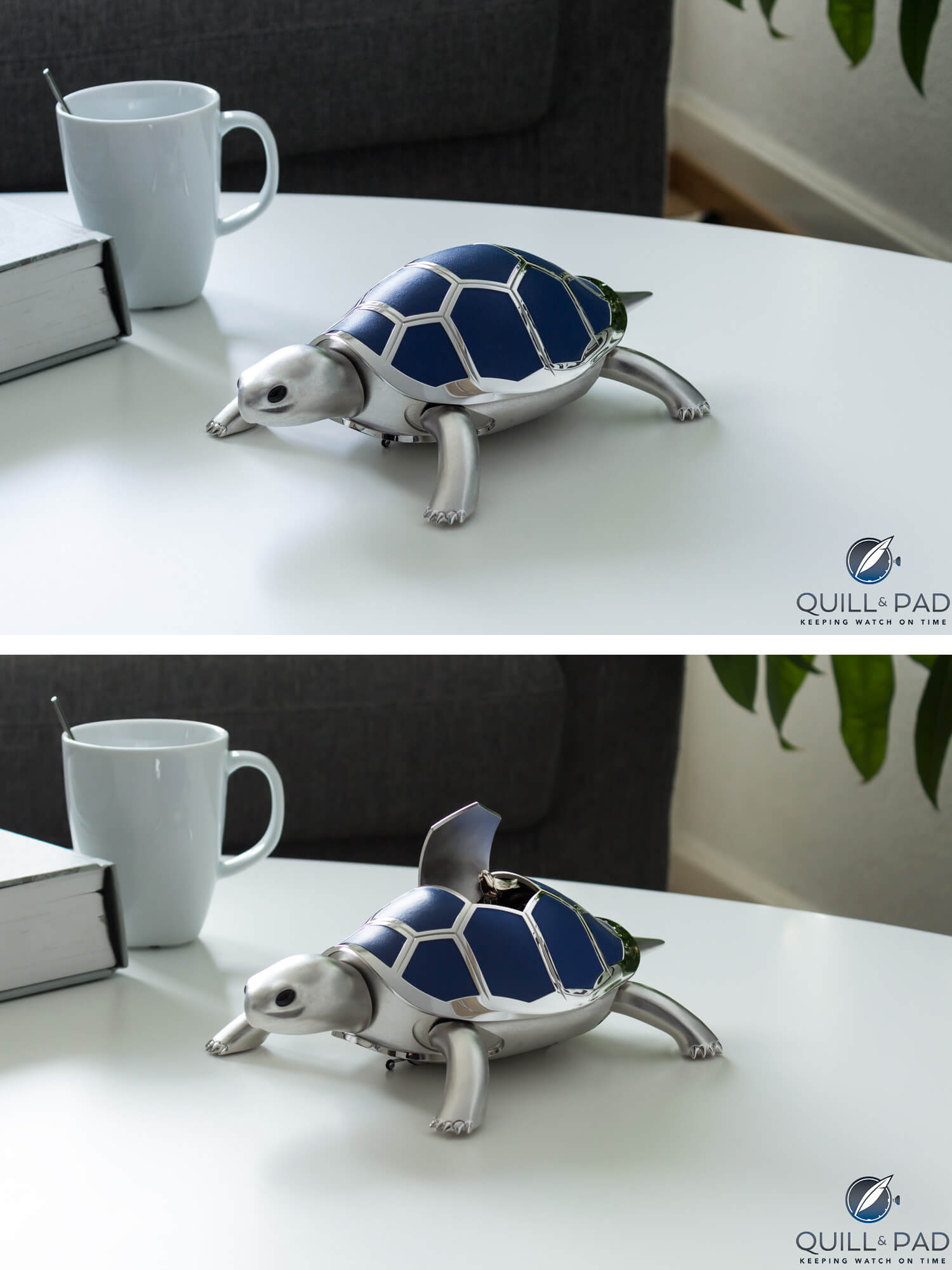
MB&F Kelys & Chirp open and closed
And in case you were interested, know that elephants too have a long history in horology.
For more information, please visit www.mbandf.com/en/machines/co-creations/Kelys-Chirp.
Quick Facts MB&F Kelys & Chirp
Case: rhodium-plated brass, stainless steel, white gold (Chirp), leather with colored calfskin (tortoise scales); 24 cm (length) x 16 cm (width) x 8 cm (height without bird open); approx. 1.4 kg (weight)
Movement: manually wound by key (tortoise belly), 480 total components, twin-cam mainspring barrel, double bellows system (bidirectional air pushing), security mechanism, power reserve: 3 cycles of turtle walking and bird singing
Functions: walking turtle (10-12 seconds, average speed 30 millimeters per second), singing bird that flaps wings, moves tail, and opens beak
Limitation: 4 editions of 18 pieces each (blue, green, yellow, ochre)
Price: 49,000 Swiss francs + applicable sales tax





















































Trackbacks & Pingbacks
[…] […]
Leave a Reply
Want to join the discussion?Feel free to contribute!